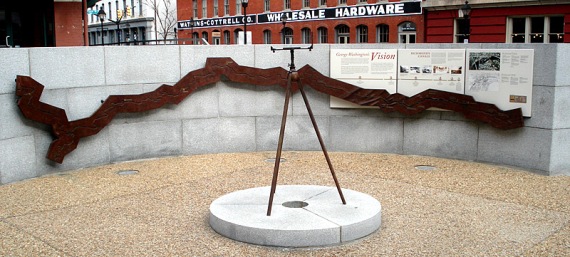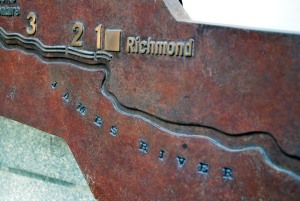 WHAT: “George Washington’s Vision” at the Canal Walk Turning Basin in downtown Richmond, Virginia.
WHAT: “George Washington’s Vision” at the Canal Walk Turning Basin in downtown Richmond, Virginia.
LOCATION: West of the intersection of 14th and Dock streets.
 ARTIST: Applebaum Associates Inc.
ARTIST: Applebaum Associates Inc.
DEDICATION: 2001
DESCRIPTION: The granite and bronze display is arranged in a circle and centered with a surveyor’s compass. The text and map within the display highlight the key points of the Kanawha Canal and Washington’s vision of connecting the Atlantic Ocean to the Mississippi River.
* * *
George Washington promoted the concept of a great central waterway long before he became this nation’s first President. A surveyor of western lands as a young man, and later a landowner of vast tracts beyond the Alleghenies, Washington had close knowledge of the western territories, which he feared would be controlled by France and Spain if trade routes to eastern markets were not established.
Washington’s vision was to connect the Atlantic Ocean to the Mississippi River with navigable rivers, canals, and a land portage through what is now West Virginia. After the Revolution, the James River Company was created, primarily as a result of his sponsorship and lobbying efforts. Before Washington’s death in 1799, a large portion of his dream had been realized.
Two canals bypassed the falls of the James River at Richmond, and 220 miles of river improvements extended westward. In the early 19th century, other farsighted Virginians took over Washington’s leadership role. The final elements of his plan were completed in the 1820s, when the Kanawha Turnpike joined the headwaters of the James River to the Kanawha River. In 1835, the James River and Kanawha Company was formed, and within 15 years a canal system stretched to Buchanan, Virginia, a distance of 197 miles.















Comments & trackbacks